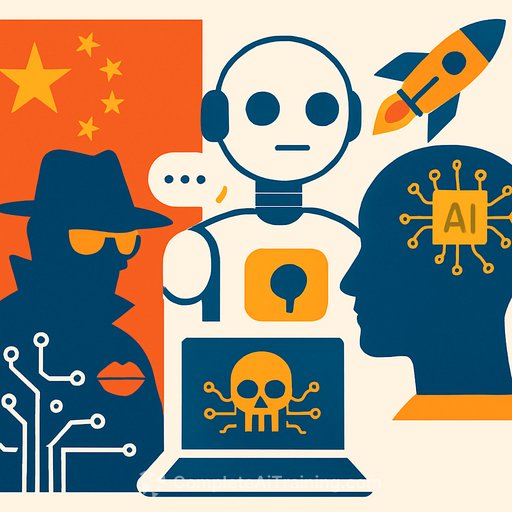Inside the Chinese AI Threat to U.S. Security
The AI debate in Washington is driven by concern over China's speed, scale and intent. Beijing is pouring billions into research, chips and infrastructure, which shapes tariffs, energy policy and the White House's AI agenda.
The economic risk is obvious: whoever leads AI gains leverage over 21st-century markets. The security picture is broader - from hacking and data collection to propaganda and the long bet on superintelligence.
What's Different Now
Senior officials say China fields the highest-quality AI among U.S. adversaries. The threat isn't a single weapon; it's a stack: cyber ops, data capture, narrative control, model corruption and long-horizon strategic instability.
1) Cyberwar, Supercharged
Chinese state-linked groups like Volt Typhoon and Salt Typhoon have penetrated U.S. telecom and infrastructure. AI can speed up reconnaissance, automate intrusion steps and optimize disruption across critical systems.
As one expert put it, AI can "accelerate, extend and automate" cyber operations, including degrading navigation or infrastructure during a crisis. See the U.S. government's advisory on Volt Typhoon for tactics and mitigations here.
2) Chatbot-Enabled Espionage
Chinese AI systems collect user data that can be pooled with other sources under civil-military fusion. China's National Intelligence Law compels companies to support state intelligence, which raises the stakes for any U.S. user data flowing to those platforms.
That dataset can refine targeting, from bespoke phishing to disinformation aimed at first responders, financial workers or military families. Lower-cost Chinese models could expand reach, scaling both collection and influence. Read the law's translation here.
3) Propaganda Baked Into Answers
Research shows leading Chinese chatbots - DeepSeek, Baidu's Ernie and Alibaba's Qwen - often align with state narratives across sensitive topics. In markets where Chinese AI is cheaper and more available, the effect multiplies.
The result isn't a single message but a patterned worldview that tilts interpretations in Beijing's favor. That matters for foreign audiences, undecided voters and low-information environments.
4) "Data Poisoning" for Military AI
Embedded models that support operations could be corrupted with triggers that activate in a crisis. A system could subtly skew options or rankings to favor PLA objectives during a Taiwan contingency.
This threat sits at the software and model layer, not just networks. It targets the trust users place in decision aids.
5) The Superintelligence Risk
Two races are running in parallel: commercial AI and a push toward artificial superintelligence. If an actor achieves decisive AI capability first, it could upset nuclear deterrence and crisis stability.
Experts warn an ASI controlled by the PLA could neutralize parts of the U.S. strategic arsenal. That would shift red lines across the Indo-Pacific and beyond.
What Public-Sector Leaders Can Do Now
- Set procurement guardrails: Prohibit Chinese AI services for any data that could be sensitive or linkable to personnel, operations or infrastructure. Require vendor attestations on data handling, model hosting and sub-processors.
- Reduce prompt exposure: Ban sensitive data in prompts. Turn off chat logs by default where possible. Use brokered gateways that scrub PII, secrets and operational details before requests leave the network.
- Block risky endpoints: Maintain an approved model list. DNS- and firewall-block Chinese AI domains across government devices. Enforce the same for contractors handling government work.
- Tighten identity and access: Apply zero trust principles. Enforce phishing-resistant MFA, least privilege and continuous device posture checks, especially for operators of ICS/OT.
- Harden critical infrastructure: Segment OT from IT. Audit remote administration tools. Monitor for "living off the land" techniques tied to PRC actors. Pre-stage backups and out-of-band comms.
- Secure the AI supply chain: Require model provenance, versioning, evaluation reports and red-team results. Test for hidden behaviors and triggers before deployment. Re-validate after updates.
- Detect influence operations: Stand up monitoring for narrative shifts across languages and platforms. Use content provenance and rapid takedown workflows with platforms and ISPs.
- Educate the workforce: Train officials on safe AI use, prompt OPSEC and common lures tied to job function. Prohibit personal-account AI use for government work.
- Exercise now: Run tabletop drills for Volt Typhoon-style incidents, targeted disinfo at key staff and corrupted decision-support tools. Include legal, comms, ops and interagency escalation paths.
- Coordinate with allies: Share indicators, model evals and attack patterns. Align on restrictions for high-risk AI vendors and common standards for audits.
Questions to Ask Your Team This Week
- Which AI endpoints can our users reach today, and which are blocked?
- What sensitive data could leak through prompts or logs, and how are we scrubbing it?
- Do we have a red-team plan for models embedded in mission systems?
- How are we monitoring for spearphishing and tailored narratives against our personnel?
- If we lost telco or cloud services in a coordinated attack, what's our communications fallback?
Where to Skill Up
If your role touches policy, procurement or operations, build AI literacy now. See role-based learning paths here.
Bottom Line
China's AI push isn't just an economic contest. Treat Chinese AI services as collection nodes, influence systems and potential attack surfaces - and act accordingly.
Small policy upgrades now beat large cleanups later. Set controls, test them, and keep iterating as the threat adapts.
Your membership also unlocks:






